Satok Market
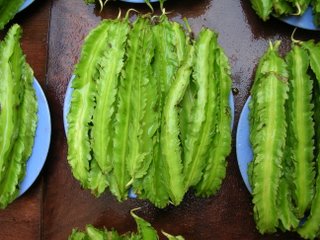 The Sunday Morning Market in Satok is a wonderful experience. You can meet your friends there, make new friends, walk among the heady aroma of exotic spices, obtain the bounty of the rainforest, select the best crabs and locate entire string rays for sale. Many of the vendors arrive the day before and sleep overnight Saturday so they can start bright and early at 5 am Sunday. They say you can find wild boar, birds in cages and turtles, although I haven't tried.
The Sunday Morning Market in Satok is a wonderful experience. You can meet your friends there, make new friends, walk among the heady aroma of exotic spices, obtain the bounty of the rainforest, select the best crabs and locate entire string rays for sale. Many of the vendors arrive the day before and sleep overnight Saturday so they can start bright and early at 5 am Sunday. They say you can find wild boar, birds in cages and turtles, although I haven't tried.
Even if you arrive at 8 am as we do, you will be late. Parking is at a premium as the whole area around the market is packed. Waiting for my friends to find a spot, I meet an older man who has already finished his weekly marketing. He had locked his bicycle close to the edge of the road near the entrance. We chat for a couple of minutes as he balances his weekly supplies in plastic bags on both sides of the handlebars and stores the dry products in the stuff bag at the back.
"I am come every week", he tells me. "Flesh, very flesh."

Wheeling his bike out between the crowded vehicles, he waves jauntily and rides off home obviously pleased with his weekly shopping. I am so much enjoying talking to him, I am slow with my camera.
You can find all the specialties of the rainforest and South China Sea in Satok. There are large packages of midin or fiddleheads, their slender, coiled fern heads peeping out of wrapped banana leaf packages, bamboo shoots smoked or plain and snake fruit, buah salak, with its leathery brown skin covering a luscious,whiteish-yellow fruit which is eaten plain or with a soy sauce dip. Dragon fruit with its white flesh studded with small soft black seeds and bundles of wild greens of all kinds are all on disply. Some vendors have a small variety of different produce, obviously from their own garden. Others have enormous quantities of one or two items. A number have the ingredients for the complete meal in one place, chili pepper, onions, jack fruit, lemon, tomatoes and ginger. You don't need to go to anyother place to collect your ingredients.
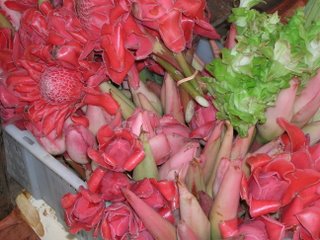
Ruffled beans also called square beans because they have four corners to them and long beans as well as many wild greens are in large piles and small mounds. The lovely flowers of the gingerplant are also eaten and are prettily displayed. We had one in our garden which was beautiful. I was horrified when the decision was made to eat it.
 I watch several people who drop by the stalls offering sago worms or grubs. The fat white worms are still alive in plastic dishes that contain small pieces of sago bark. Care goes into selecting them. They are a real delicacy for some groups here such as the Melanau. They can be eaten fresh or fried and are said to be cure for asthma. I wonder if these tasty morsels are some of the items we watch people eat on shows like Survivor.
I watch several people who drop by the stalls offering sago worms or grubs. The fat white worms are still alive in plastic dishes that contain small pieces of sago bark. Care goes into selecting them. They are a real delicacy for some groups here such as the Melanau. They can be eaten fresh or fried and are said to be cure for asthma. I wonder if these tasty morsels are some of the items we watch people eat on shows like Survivor. 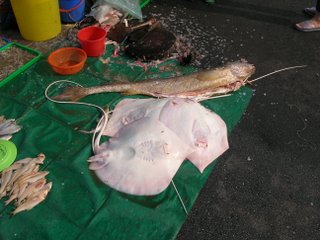 The fish section is particularly large and active. It includes both dry and fresh fish. To one side, young guys cut and gut fish in clean rapid strokes. They show me the roe or eggs of the fish which are sold separately and practice their English.
The fish section is particularly large and active. It includes both dry and fresh fish. To one side, young guys cut and gut fish in clean rapid strokes. They show me the roe or eggs of the fish which are sold separately and practice their English.Crabs are held in plastic tubs with grates over the top. Each crab has been tied up with a thin piece of string over the carapace which holds their front claws so they can not damage each other. One customer wants only females. Assisted by the vendor, she goes through two of the tubs checking until she finds females. There aren’t many. It looks to me like she is going for them all. People here have very distinct tastes for fish. Some only buy shrimp at certain times of the moon. We look on the internet to see if we can find anything about why that is so and find a webside which outlines research being done on tide tables (phases of the moon) and quality differences. Why not, we think? More Old Wives Tales with a solid basis in fact.
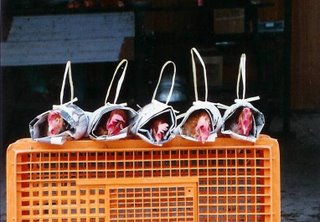
While the fish section is the most crowded, has the most variety and seems to attract the most attention, there are also lots of live and dead chickens. The live chickens are trussed up in packages with string loops for holding them, so you can check them out and haul them home easily. The man selling dead chickens is declawing all the feet which will also be sold. Vendors don't do much sitting around in this market.
Some stalls feature cooked food for consumption on site and for take out. Bamboo skewers are being slowly cooked over hot coals in metal drums that have been sectioned in half. You can select the meat or fish you want and then wait for it to be cooked. This grilling is one of the finest ways for bringing out the taste and is a high art in Malaysia. Often the meat is dusted with spices. There is a section of the market where Indian woman have spread out containers of various different spices and curry mixes. Maybe we should just try a small amount each week until we discover the best one, I think.
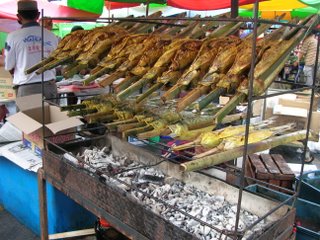
I stroll down the fish section. Sting Ray is available. Today there is even a whole string ray which is rather unusual. There are red snapper in a range of sizes, which I can recognize from the Pacific coast. A variety of eels are offered smoked, dried and fresh. Periwinkles, snails, clams and shrimp of many sizes and colours are found. The dry fish section is huge. Even the smallest sardines have been sorted into sacks of different prices. While undertaking my tour of the fish market, one of the professors from the university hails me. Later I run into a couple from our compound. It seems everyone is here.
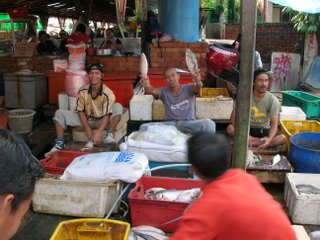 For a time I lose sight of my friends. I have been taking too many pictures. The young fellows gutting fish are concerned to see me scanning the area.
For a time I lose sight of my friends. I have been taking too many pictures. The young fellows gutting fish are concerned to see me scanning the area.“Are you lost?” they inquire.
“No, I think my friends are lost, because they are so short I can't see them”, I say.
“I am tall, they can easily find me”.
Near the fish section of the market, right beside the entrance, there is a van packed with sacks of ice. Hygienic Ice, says the sign on the side of the white van. A young, well-built man pulls out huge sacks, loads them on the dolly and wheels them into the fish section. He brings back empty sacks. By the time he has his next dolly piled high with 2 sacks, it is time to move it to the fish stalls.
In Satok Market you appreciate the work that is behind the food we eat. You are aware of how many people are involved and how much the market and food is a part of life here. It's a whole world intimately linked with the land and sea.
Photos: square beans, man leaving Satok with weekly shopping, sago grubs, midin, ginger flowers, sting ray, BBQ treats, cocks, guys gutting fishes
Labels: Sarawak


2 Comments:
Great blog and welcome to Sarawak. I have added you in my list as one of the interesting blogging comrade in Sarawak :)
Thank you for the post - and the pictures! You bring it all to life for us!
You make wish I could travel!
Have you tried all of those local goodies?
Post a Comment
<< Home